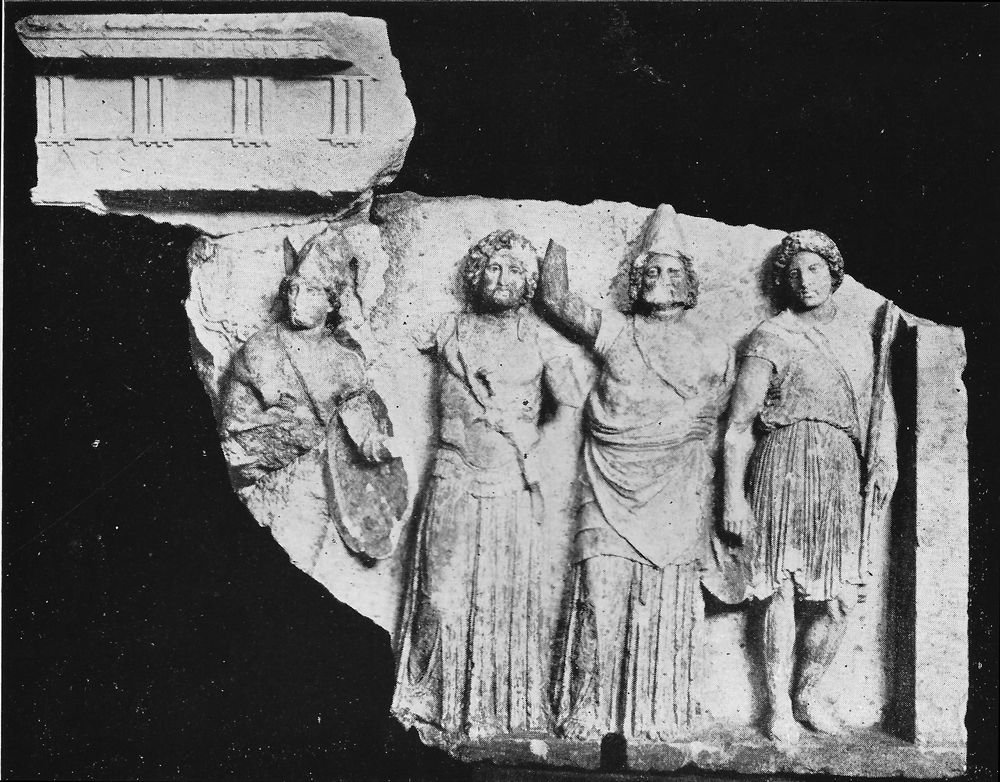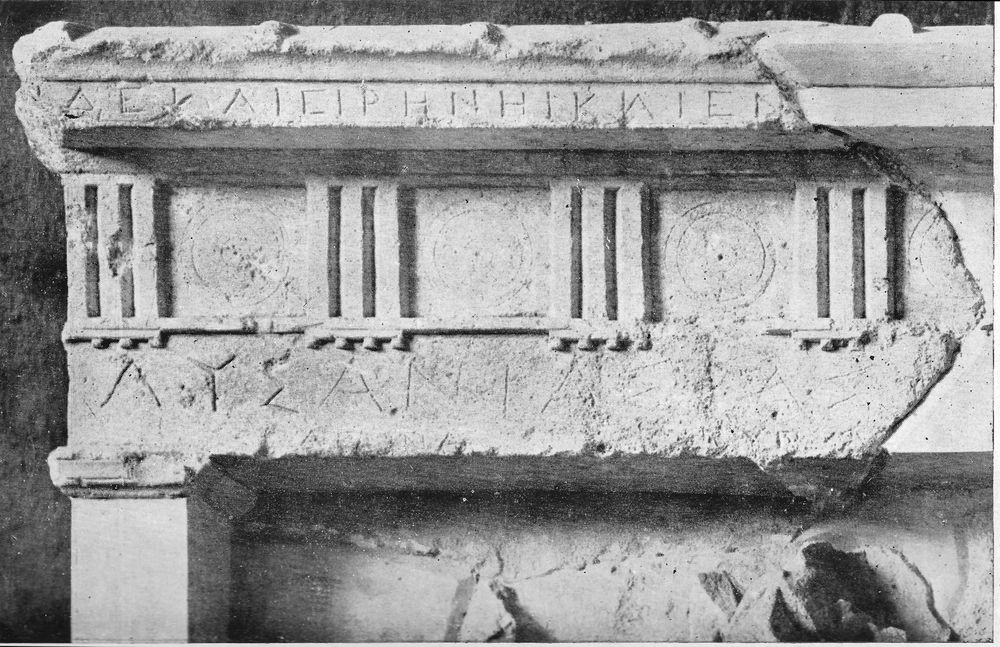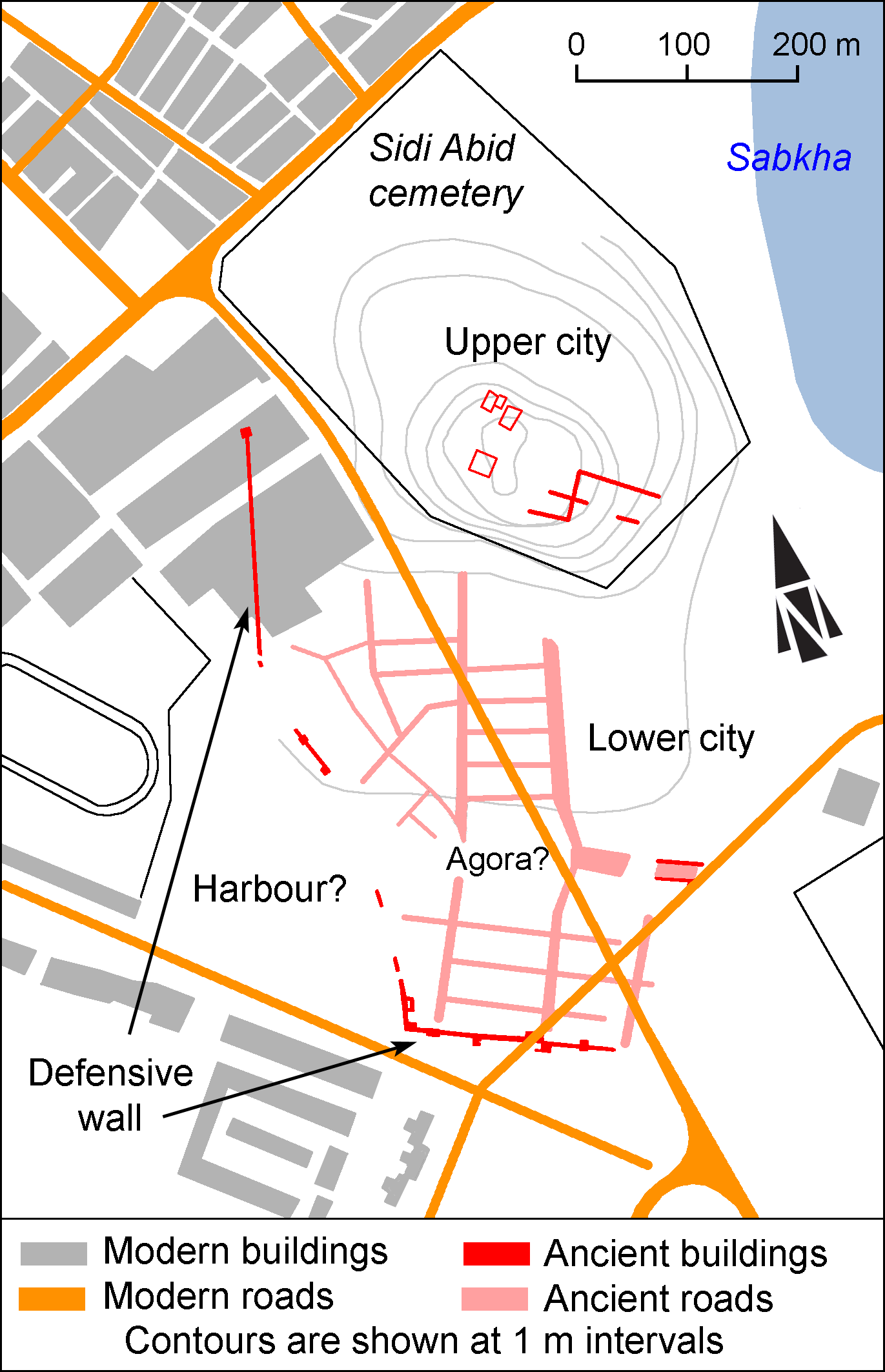EpiDoc XML:
GVCyr0212
Trismegistos ID:
738914
Source description
Support: Block of local limestone worked in the shape of a naiskos with antae at both sides; on top, an architrave surmounted by a Doric frieze of metops and triglyphs, then a cornice and a line of tiles. On a listel below stood five figures in relief, of which the first from the left is lost, but for part of a head-veil. Only 4/10 of the architrave and frieze are preserved at left (dimensions of the whole monument w: 1.41 × h: 1.06).
Layout: Inscribed a) on the rim of the cornice (height 0.067); b) on the upper part of the architrave (height 0.097); c) near the lower rim of the architrave, in correspondance with each figure: i) above the first (lost) figure from left, ii) above the second figure from left, while three other captions (iii, iv, v) were presumably cut above the other figures, but are lost.
Letters: a) 0.014-0.018; b) 0.031-0.04; c) 0.011; all letters contemporaneous, without serifs; epsilon with very short middle bar, slighlty dissymmetrical nu, slanting sigma.
Date: Perhaps ca. 350 BC (lettering, context).
Findspot: Found in 1915 in the vicinity of Euesperides ➚ at Es Sabri, East of the site of Euesperides.
Place of origin: Findspot.
Last recorded location: Observed by Fr. Chamoux in 1947 in Shahat: in the Cyrene Museum. Observed by S. Stucchi between 1957 and 1981 at Benghazi: in the Benghazi Museum. Never seen by GVCyr team.
Text constituted from: Transcription from previous editors (CDL).
Bibliography
Ghislanzoni 1927, with addendum p. 249; Ferri 1927; Oliverio 1932-1933, pp. 183-194 and fig. 70-71; from the three precedings SEG, 9.769; Stucchi 1987, whence SEG, 37.1664; GVCyr 021 ➚. Cf. Chamoux 1953, p. 279; Laronde 1987, p. 411, footnote 101; CEG II.851; Dobias-Lalou 2000, pp. 221-222.
Text
Apparatus
a.1: Εἰρήνηι καὶ Ἐν[υαλίωι] CEG, Dobias-Lalou 2000: εἰρήνηι κ«α»ὶ ἐν [πολέμωι?] Oliverio 1932-1933; Εἰρήνηι καὶ Ἐν[δυμίωνι] Ghislanzoni 1927; Εἰρήνηι καὶ Ἐν[υοῖ] Ghislanzoni 1927; Εἰρήνηι καὶ Ἐν[νοίαι] Ghislanzoni 1927; Εἰρήνηι καὶ Ἐν[οδίαι] Ghislanzoni 1927; Εἰρήνηι καὶ Ἐν[υοῖ] Ferri 1927; Εἰρήνηι καὶ Ἐν[υαλίωι] Ferri 1927; [Ἐν] δὲ καὶ εἰρήνηι καὶ ἐν [πολέμωι ἥρωες καὶ ἡρῷσσαι ἐγγένεις ἐπηκόοι] Stucchi 1987 || [ἀνέθηκαν] Ferri 1927: [μ' ἀνέθηκαν?] CEG; [---] Ghislanzoni 1927, Oliverio 1932-1933; [δεκάταν ἀνέθηκη sic!] Stucchi 1987 || [---] all editors omit this gap
c.1: [.?]αΓ̣[.]να: ἀγ[ῶ]να Ghislanzoni 1927, Ferri 1927; Ἄπ[οι?]να Oliverio 1932-1933; Ἀγα̣νά Stucchi 1987
c.2: [Εὐρ]ύπυλ[ος] Oliverio 1932-1933; [Εὐρ]υπύλ[ου] Ghislanzoni 1927; [Εὐρ]ύπυλ[ον] Ferri 1927
French translation
Voici ceux qui à Eirènè et En[yalios ont consacré? ---]:
Lysanias fils d'Iasôn, [Untel fils d'Untel].
[---]na; Eurypylos; [---]; [---]; [---].
English translation
Those to Eirene and En[yalios dedicated? ---]:
Lysanias son of Iason, [So-and-so son of So-and-so].
[---]na; Eurypylos; [---]; [---]; [---].
Italian translation
Questi a Eirene e a En[yalios hanno dedicato? ---]:
Lysanias figlio di Iason, [il tale figlio del tale].
[---]na; Eurypylos; [---]; [---]; [---].
Commentary
This unique relief, found not far from the site of Euesperides, was clearly related to that city. Both style of sculpture and lettering give clues to a date about the middle of the fourth century. When found, it was still painted in vivid colours that fainted quickly. Moved to Tripolitania during World War II, then brought to Cyrene and back to Benghazi, it has been exposed in the Museum of that city. The hazardous circumstances of that Museum do not allow to give clear indications about its present condition.
Only Ghislanzoni suspected verse here, but he tried to link all lines together, producing a very strange sentence. At a), the use of non-dialectal forms at line 1 shows that the text was verse. Furthermore, at the beginning of the text, the only possible restoration is οἵδε, a demonstrative plural. So we must assume that Lysanias was not the only dedicator and there is in fact enough space for at least one other name.
It is now admitted that the names in c) were all at the nominative, being captions with the name of each figure. There has been overflowing discussion about the figures. The only clear name, Eurypylos, refers to the episod of the Argonautae at lake Triton (i.e. the sabkha As-Salmani near Euesperides). Saying that he was a son of Poseidon, he helped them out of the lake and predicted the foundation of Cyrene by a descendant of Euphemus. But no other character of that myth has been clearly identified. Other explanations suggest unidentified Libyan deities. What can be said from an epigraphical point of view is that the first name was a feminine; a first letter might have been lost before the first readable alpha. Stucchi's suggestion (forwarded by Chamoux's unpublished copy) of a feminine name Ἀγάνα, meaning 'Mild', is an interesting possibility, as there is one occurrence from Athens as a woman's name. However, no heroine of that name is known.
Metrical analysis of a): a dactylic hexameter was plausibly followed by a lost pentameter, for which there seems to be enough space in the lost part.
CC BY-NC-SA 4.0 Deed Attribution-NonCommercial-ShareAlike 4.0 International License.
All citation, reuse or distribution of this work must contain a link back to DOI: https://doi.org/10.60760/unibo/igcyrgvcyr2 and the filename (IGCyr000000 or GVCyr000), as well as the year of consultation.



